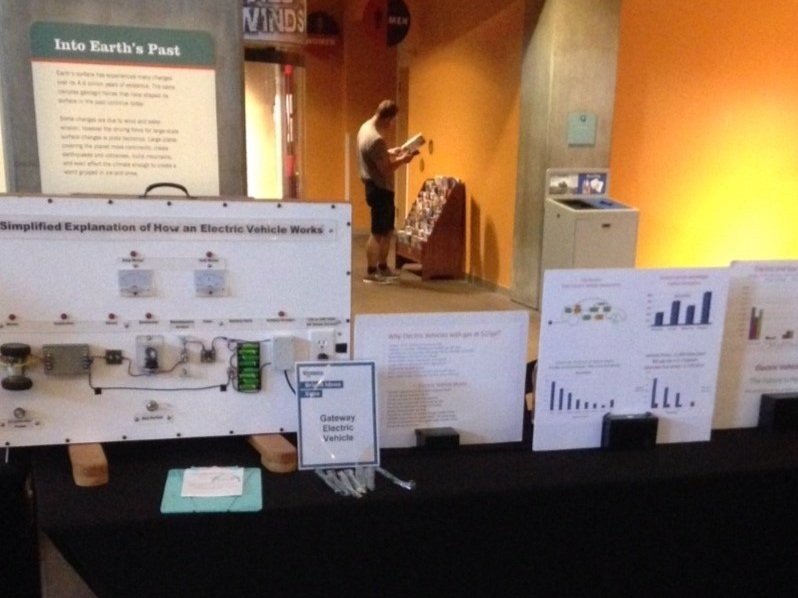EV gateway
St. Louis chapter spreads the message locally
Caravan of GEVA EVs leave the Saint Louis Science Center McDonnell Planetarium
The Gateway Electric Vehicle Association (GEVA) has forged partnerships in the St. Louis area that have proved successful in expanding outreach.
Certainly, the chapter’s cooperation with the Saint Louis Science Center has been very fruitful for both parties. For GEVA, the center has provided needed space for chapter meetings, as well as larger space for National Drive Electric Week (NDEW) events. For the Science Center, GEVA is an important resource when it comes to electric vehicles (EVs).
“One of our members worked at the science center; that’s how all this started,” said Wayne Garver, President of GEVA. “It’s been a very productive partnership, and it’s because they like us to show our cars there. They especially like the conversion vehicles because they’re different.”
EV display facilitated by GEVA at the Saint Louis Science Center
“I’m a volunteer at the center,” Garver continued. “I’m always talking to them about what we can do for the kids. Last spring, an educator in the YES (Youth Exploring Science) Program called me up, wanting to know if they could borrow our chapter’s electric go-kart.”
This go-kart, Garver explained, dates back to 2007, when chapter members built and electrified a very basic, homegrown version after a founding member thought it would be effective to show at outreach events.
“So we loaned the go-kart to the science center, and that was helpful for the YES Program,” Garver explained. “The kart demonstrates what is inside an EV since you can see all of the components.”
The GEVA go-kart at the Saint Louis Science Center
A history that goes back
GEVA has a history that very much involves the aforementioned conversions.
“The club started in 2006, when you couldn’t buy an electric car. Most of the members were much more interested in building one,” Garver said, explaining that some of the early members worked as engineers for McDonnell Douglas and NASA. “These are guys who were doing solar back in the Eighties.”
“I’d done a conversion with lead acid batteries in 1982 on a 1971 VW Beetle,” Garver continued. “My goal at the time was to drive it to work 10 miles away, at the Department of Physics at the University of Missouri.
Wayne Garver with his 1971 VW conversion
“I had to build a controller from a kit,” continued Garver, who was a member of the Electric Auto Association at that time. “It wasn’t a tall order because I did electronics, but I did have some problems with the controller. Transistors were not as good as they are now. I kept burning them out.”
Garver drove the Beetle back and forth to work for one year, but “Then I got married and it sat in my garage for 25 years,” he said.
Rebirth of a bug
In 2007, once the Garver children had left the house, Wayne took the Beetle out of the garage. In 2013, he installed lithium batteries, and in 2017, he replaced the stalled-out DC motor with an AC version. Later, he made additional enhancements, including the installation of heaters for the battery and the passenger compartment.
Today, the Beetle is Garver’s daily driver, giving him a range of approximately 90 miles. “It can travel 100 miles if I keep it at 40 miles per hour, and about 70 miles if I take it on the highway,” he explained. “I charge the car on the solar array in my back yard. That gives me 30 miles on a sunny day.”
Last summer, Garver put his VW to a test at a GEVA-sponsored event at the World Wide Technology Raceway, a NASCAR drag strip east of St. Louis in Illinois that is known as a prime spot for Tesla drivers to compete against each other.
Billed as an “Electric Vehicle Race Day,” the competition featured Garver in his Bug against fellow GEVA chapter member Dandan TheDrivingMan, a local personality and EV advocate. TheDrivingMan entered the race in a 2017 Nissan LEAF with a solar panel on the roof and plastic tires in the rear to enable drifting.
Wayne Garver (background) and Dandan TheDrivingMan at the World Wide Technology Raceway before the race between them
“Wayne had never gone all out in his car,” said TheDrivingMan, who has logged over 200,000 miles on his LEAF. “Neither one of us had been on a drag strip before. We invited the whole chapter to come watch, and a number of members did show up.”
“When the race was about to start, I looked down and realized I was in double ECO mode, which I knew was not the best way to start on a drag strip,” TheDrivingMan continued. “Then the light turned green, but I noticed that Wayne was just sitting there, not moving, so I yelled toward him, ‘Wayne, it’s green, go!!’ He finally took off and now I’m off of ECO mode, and I floored it.”
What followed was what both men call “the slowest car race in history.” Indeed, their competition did set the record for the slowest race ever at the World Wide Technology track.
“We did our part with that race in calling attention to EVs,” Garver concluded. “And at the end of the day, that’s what always matters most.”





